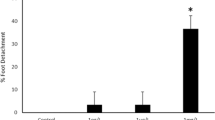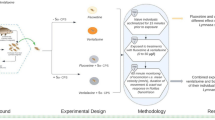Abstract
Exposure to human antidepressants has been shown to disrupt locomotion and other foot-mediated mechanisms in aquatic snails. We tested the effect of three selective serotonin reuptake inhibitor (SSRI)- and one selective serotonin-norepinephrine reuptake inhibitor (SNRI)-type antidepressants on the righting response in the marine snail, Ilyanassa obsoleta. All four antidepressants (fluoxetine, sertraline, paroxetine, venlafaxine) significantly increased righting time compared with controls with an exposure time as short as 1 h. Dose responses were nonmonotonic with effects seen mainly at the lowest exposure concentrations and shortest duration. The lowest concentration to show an effect was 3.45 μg/L fluoxetine with a 2-h exposure period and is about 3.71 times higher than environmental concentrations. Our results highlight rapid disruption of another foot-mediated behavior in aquatic snails by SSRI-type antidepressants. We discuss these and other reported nonmonotonic dose responses caused by antidepressants in terms of the various possible physiological mechanisms of action in nontarget aquatic species.




Similar content being viewed by others
References
Bidel F, Di Poi C, Imarzzene B, Koueta N, Budzinski H, Van Delft P, Bellanger C, Jozet-Alves C (2016) Pre-hatching fluoxetine-induced neurochemical, neurodevelopmental, and immunological changes in newly hatched cuttlefish. Env Sci Poll Res 23(6):5030–5045
Bisesi JH, Sweet L, van den Hurk P, Klaine SJ (2016) Effects of an antidepressant mixture on the brain serotonin and predation behavior of hybrid striped bass. Environ Toxicol Chem 35(4):938–945
Bossus MC, Guler YZ, Short SJ, Morrison ER, Ford AT (2014) Behavioural and transcriptional changes in the amphipod Echinogammarus marinus exposed to two antidepressants, fluoxetine and sertraline. Aquat Toxicol 151:46–56
Bringolf RB, Heltsley RM, Newton TJ, Eads CB, Fraley SJ, Shea D, Cope WG (2010) Environmental occurrence and reproductive effects of the pharmaceutical fluoxetine in native freshwater mussels. Environ Toxicol Chem 29(6):1311–1318
Brodin T, Piovano S, Fick J, Klaminder J, Heynen M, Jonsson M (2014) Ecological effects of pharmaceuticals in aquatic systems—impacts through behavioural alterations. Phil Trans R Soc B 369:20130580
Brooks BW, Turner PK, Stanley JK, Weston J, Glidewell EA, Foran CM, Slattery M, La Point TW, Huggett DB (2003) Waterborne and sediment toxicity of fluoxetine to selected organisms. Chemosphere 52:135–142
Brown KM, Alexander JE, Thorp JH (1998) Differences in the ecology and distribution of lotic pulmonates and prosobranch gastropods. Am Malacol Bull 14(2):91–101
Bueno MJM, Aguera A, Gomez MJ, Hernando MD, Garcia-Reyes JF, Fernandez-Alba AR (2007) Application of liquid chromatography/quadrupole-linear ion trap mass spectrometry and time-of-flight mass spectrometry to the determination of pharmaceuticals and related contaminants in wastewater. Anal Chem 79:9372–9384
Conners DE, Rogers ED, Armbrust KL, Kwon JW, Black MC (2009) Growth and development of tadpoles (Xenopus laevis) exposed to selective serotonin reuptake inhibitors fluoxetine and sertraline, throughout metamorphosis. Environ Toxicol Chem 28:2671–2676
Connors KA, Valenti TW, Lawless K, Sackerman J, Onaivi ES, Brooks BW, Gould GG (2014) Similar anxiolytic effects of agonists targeting serotonin 5-HT1A or cannabinoid CB receptors on zebrafish behavior in novel environments. Aquat Toxicol 151:105–113
Daughton CG, Ternes TA (1999) Pharmaceuticals and personal care products in the environment: agents of subtle change? Environ Health Perspect 107(Supplement 6):907–938
De Lange HJ, Noordoven W, Murk AJ, Lurling MFLLW, Peeters ETHM (2006) Behavioural responses of Gammarus pulex (Crustacea, Amphipoda) to low concentrations of pharmaceuticals. Aquat Toxicol 78:209–216
De Lange HJ, Peeters ET, Lurling MFLLW (2009) Changes in ventilation and locomotion of Gammarus pulex (Crustacea, Amphipoda) in response to low concentrations of pharmaceuticals. Hum Ecol Risk Assess 15:111–120
Denny MW, Gaines SD (2007) Encyclopedia of tidepools and rocky shores. University of California Press, Berkeley 735pp
Di Poi C, Bidel F, Dickel L, Bellanger C (2014) Cryptic and biochemical responses of young cuttlefish Sepia officinalis exposed to environmentally relevant concentrations of fluoxetine. Aquat Toxicol 151:36–45
Domokos G, Varkonyi PL (2008) Geometry and self-righting of turtles. Proc RoyalSoc B 275:11–17
Downing C (2004) Photolysis of venlafaxine and paroxetine in aqueous solutions. Report to the College of Saint Benedict and Saint John’s University, 8 pp
Estevez-Calvar N, Canesi L, Montagna M, Faimali M, Piazza V, Garaventa F (2016) Adverse effects of the SSRI antidepressant sertraline on early life stages of marine invertebrates. Mar Environ Res. doi:10.1016/j.marenvres.2016.05.021
Faimali M, Gambardella C, Costa E, Piazza V, Morgana S, Estevez-Calvar N, Garaventa F (2016) Old model organisms and new behavioral end-points: swimming alteration as an ecotoxicological response. Mar Environ Res. doi:10.1016/j.marenvres.2016.05.006
Fei G, Guo C, Sun H-S, Feng Z-P (2007) Chronic hypoxia stress-induced differential modulation of heat-shock protein 70 and presynaptic proteins. J Neurochem 100:50–61
Feito R, Valcarcel Y, Catala M (2013) Preliminary data suggest that venlafaxine environmental concentrations could be toxic to plants. Chemosphere 90:2065–2069
Fong PP (1998) Zebra mussel spawning is induced in low concentrations of putative selective serotonin reuptake inhibitors (SSRIs). Biol Bull 194:143–149
Fong PP, Hoy CM (2012) Antidepressants (venlafaxine and citalopram) cause foot detachment from the substrate in freshwater snails at environmentally relevant concentrations. Mar Freshw Behav Physiol 45(2):145–153
Fong PP, Molnar N (2013) Antidepressants cause foot detachment from substrate in five species of marine snail. Mar Environ Res 84:24–30
Fong PP, Bury TB, Dworkin-Brodsky AD, Jasion CM, Kell R (2015) The antidepressants venlafaxine (“Effexor”) and fluoxetine (“Prozac”) produce different effects on locomotion in two species of marine snail, the oyster drill (Urosalpinx cinerea) and the starsnail (Lithopoma americanum). Mar Environ Res 103:89–94
Ford AT, Fong PP (2016) The effects of antidepressants appear to be rapid and at environmentally relevant concentrations. Environ Toxicol Chem 35(4):794–798
Franzellitti S, Buratti S, Capolupo M, Du B, Haddad SP, Chambliss CK, Brooks BW, Fabbri E (2014) An exploratory investigation of various modes of action and potential adverse outcomes of fluoxetine in marine mussels. Aquat Toxicol 151:14–26
Gore RH (1966) Obsevations on the escape response in Nassarius vibex (say), (Mollusca: Gastropoda). Bull Mar Sci 16(3):423–434
Gros M, Petrovic M, Barcelo D (2007) Wastewater treatment plants as a pathway for aquatic contamination by pharmaceuticals in the Ebro river basin (Northeast Spain). Environ Toxicol Chem 26:1553–1562
Guler Y, Ford AT (2010) Anti-depressants make amphipods see the light. Aquat Toxicol 99:397–404
Hellou J (2011) Behavioural ecotoxicology, an “early warning” signal to assess environmental quality. Env Sci Pollut Res 18:1–11
Hellou J, Cook A, Lalonde B, Walker P, Dunphy K, Macleod S (2009) Escape and survival of Corophium volutator and Ilyanassa obsoleta exposed to freshwater and chlorothalonil. J Env Sci Health A 44:778–790
Holomuzki JR, Biggs BJF (1999) Distributional responses to flow disturbance by a stream-dwelling snail. Oikos 87:36–47
Johnson DJ, Sanderson H, Brain RA, Wilson CJ, Solomon KR (2007) Toxiity and hazard of selective serotonin reuptake inhibitor antidepressants fluoxetine, fluvoxamine, and sertraline to algae. Ecotoxicol Environ Saf 67:128–139
Kullyev ACM, Dempsey S, Miller C-JK, Hapiak VM, Komuniecki RW, Griffin CT, Sze JY (2010) A genetic survey of fluoxetine action on synaptic transmission in Caenorhabditis elegans. Genetics 186:929–941
Kwon J-W, Armbrust KL (2006) Laboratory persistence and fate of fluoxetine in aquatic environments. Env Tox Chem 25(10):2561–2568
Lawrence JM, Cowell BC (1996) The righting response as an indication of stress in Stichaster striatus (Echinodermata, asteroidea). Mar Freshw Beh Physiol 27(4):239–248
Lemmnitz G, Schuppe H, Wolff HG (1989) Neuromotor bases of the escape behaviour of Nassa mutalbilis. J Exp Biol 143:493–507
Manríquez PH, Jara ME, Mardones ML, Navarro JM, Torres R, Lardies MA, Vargas CD, Widdicombe S, Salisbury J, Lagos NA (2013) Ocean acidification disrupts prey responses to predator cues but not net prey shell growth in Concholepas concholepas (loco). PLoS One 8(7):e68643. doi:10.1371/journal.pone.0068643
Melvin SD, Wilson SP (2013) The utility of behavioral studies for aquatic toxicology testing: a meta-analysis. Chemosphere 93:2217–2223
Mesquita SR, Guilhermino L, Guimaraes L (2011) Biochemical and locomotor responses of Carcinus maenas exposed to the serotonin reuptake inhibitor fluoxetine. Chemosphere 85:967–976
Minagh E, Hernan R, O’Rourke K, Lyng FM, Davoren M (2009) Aquatic ecotoxicity of the selective serotonin reuptake inhibitor sertraline hydrochloride in a battery of freshwater test species. Ecotoxicol Environ Saf 72:434–440
Minguez L, Di Poi C, Farcy E, Ballandonne C, Benchouala A, Bojic C, Cossu-Leguille C, Costil K, Serpentini A, Lebel J-M, Halm-Lemeille M-P (2014) Comparison of the sensitivity of seven marine and freshwater bioassays as regards antidepressant toxicity assessment. Ecotoxicology 23(9):1744–1754
Newland PL (1989) The uropod righting reaction of the crayfish Procambarus clarkia (Girard): an equilibrium response driven by two largely independent reflex pathways. J Comp Physiol A 164:685–696
Orr MV, El-Bekai M, Lui M, Watson K, Lukowiak K (2007) Predator detection in Lymnaea stagnalis. J Exp Biol 210:4150–4158
Painter MM, Buerkley MA, Julius ML, Vajda AM, Norris DO, Barber LB, Furlong ET, Schultz MM, Schoenfuss HL (2010) Antidepressants at environmentally relevant concentrations affect predator avoidance behavior of larval fathead minnows (Pimephales. promelas). Environ Toxicol Chem 28:2677–2684
Ranganathan R, Sawin ER, Trent C, Horvitz HR (2001) Mutations in the Caenorhabditis elegans serotonin reuptake transporter MOD-5 reveal serotonin-dependent and-independent activities of fluoxetine. J Neurosci 21:5871–5884
Rivetti C, Campos B, Barata C (2016) Low environmental levels of neuro-active pharmaceuticals alter phototactic behaviour and reproduction in Daphnia magna. Aquat Toxicol 170:289–296
Rodrigues AP, Santos LHLM, Ramalhosa MJ, Delerue-Matos C, Guimaraes L (2015) Sertraline accumulation and effects in the estuarine decapod Carcinus maenas: importance of the history of exposure to chemical stress. J Hazard Mater 283:350–358
Schaefer A, Burmann I, Regenthal R, Arelin K, Barth C, Pampel A, Villringer A, Margulies DS, Sacher J (2014) Serotonergic modulation of intrinsic functional connectivity. Curr Biol 24(19):2314–2318
Schram JB, Schoenrock KM, McClintock JB, Amsler DC, Angus RA (2014) Multiple stressor effects of near-future elevated seawater temperature and decreased pH on righting and escape behaviors of two common Antarctic gastropods. J Exp Mar Biol Ecol 457:90–96
Stahl SM (1998) Not so selective serotonin reuptake inhibitors. J Clin Psychiatry 59:343–344
Steele C (2013) Behavioral assessment of aquatic pollutants. Ethics, Policy Environ 16(2):177–187
Styrishave B, Halling-Sorensen B, Ingerslev F (2011) Environmental risk assessment of three selective serotonin reuptake inhibitors in the aquatic environment: a case study including a cocktail scenario. Environ Toxicol Chem 30:254–261
Valenti TW, Gould GG, Berninger JP, Connors KA, Keele NB, Prosser KN, Brooks BW (2012) Human therapeutic plasma levels of the selective serotonin reuptake inhibitor (SSRI) sertraline decrease serotonin reuptake transporter binding and shelter-seeking behavior in adult male fathead minnows. Environ Sci Technol 46:2427–2435
Weis JS (2014) Delayed behavioral effects of early life toxicant exposures in aquatic biota. Toxics 2:165–187
Weis JS, Smith G, Zhou T, Santiago-Bass C, Weis P (2001) Effects of contaminants on behavior: biochemical mechanisms and ecological consequences. Bioscience 51(3):209–217
Weldon PJ, Hoffman DL (1979) Kick and thrust foot movements in the righting and escape behavior of marine prosobranch gastropods (Mollusca: Gastropoda). Zeitschrift fur Tierpsychologie 50:387–398
Weston JJ, Huggett DB, Rimoldi J, Foran CM, Slattery M (2001) Determination of fluoxetine (Prozac) and norfluoxetine in the aquatic environment. Annual Meeting of the Society of Environmental Toxicology and Chemistry, Baltimore
Acknowledgments
This work was supported in part by a grant to Gettysburg College from the Howard Hughes Medical Institute through the Precollege and Undergraduate Science Education Program.
Author information
Authors and Affiliations
Corresponding author
Additional information
Responsible editor: Cinta Porte
Rights and permissions
About this article
Cite this article
Fong, P.P., Bury, T.B.S., Donovan, E.E. et al. Exposure to SSRI-type antidepressants increases righting time in the marine snail Ilyanassa obsoleta . Environ Sci Pollut Res 24, 725–731 (2017). https://doi.org/10.1007/s11356-016-7855-y
Received:
Accepted:
Published:
Issue Date:
DOI: https://doi.org/10.1007/s11356-016-7855-y




